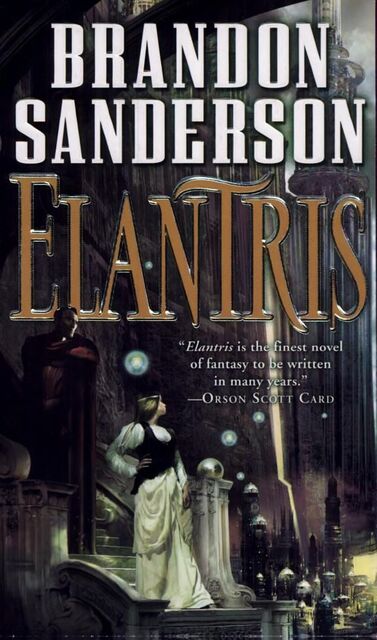Review: Elantris
Review of Elantris by Brandon Sanderson (9780765311771)★★★★
How do you summarize Elantris? It’s got mystery, magic, romance, action, political intrigue… and it all works while avoiding falling into classic fantasy tropes and cliches.

Elantris was the capital of Arelon: gigantic, beautiful, literally radiant, filled with benevolent beings who used their powerful magical abilities for the benefit of all. Yet each of these demigods was once an ordinary person until touched by the mysterious transforming power of the Shaod. Ten years ago, without warning, the magic failed. Elantrians became wizened, leper-like, powerless creatures, and Elantris itself dark, filthy, and crumbling.
Arelon's new capital, Kae, crouches in the shadow of Elantris. Princess Sarene of Teod arrives for a marriage of state with Crown Prince Raoden, hoping -- based on their correspondence -- to also find love. She finds instead that Raoden has died and she is considered his widow. Both Teod and Arelon are under threat as the last remaining holdouts against the imperial ambitions of the ruthless religious fanatics of Fjordell. So Sarene decides to use her new status to counter the machinations of Hrathen, a Fjordell high priest who has come to Kae to convert Arelon and claim it for his emperor and his god. But neither Sarene nor Hrathen suspect the truth about Prince Raoden. Stricken by the same curse that ruined Elantris, Raoden was secretly exiled by his father to the dark city. His struggle to help the wretches trapped there begins a series of events that will bring hope to Arelon, and perhaps reveal the secret of Elantris itself.
It’s been about a week and a half since I finished reading Elantris, which means once again this review is coming late, well after my initial impressions have faded. So, don’t expect too much.
Despite being his first work, this feels like classic Sanderson to me. We have reversals of classic fantasy tropes. We have powerful female characters leading the fight for justice, something which I’m discovering is a bit of a fixture in Sanderson’s work. We have, of course, a fairly coherent magic system whose rules are the key to the big reveal at the end of the novel. And, of course, we have a bit of a Sanderson avalanche at the end.
I will say, the slow reveal of the magic in this world was a bit frustrating, if only because it proves so critical in the final acts of the book. But, that issue aside, this book was well paced and exciting.
But what really made this book work for me was the characters.
Unlike the cast in The Stormlight Archives, which I generally find a bit difficult to like at times, Raoden and Sarene are both just… good. In fact, if I had to criticize, Raoden is a bit too good to be realistic at times. Sarene, by contrast, is strong, biting, witty, clever, determined, and in general just delightful.
Similarly, I found Hrathen’s journey to be a really engaging. As a foil for Sarene he was a perfect match, and I enjoyed the fact that they both clearly respected one another. And I will absolutely admit that I didn’t expect his storyline to end the way it did.
About the only real disappointment for me was Dilaf, if only because he was just so… stereotypical. I enjoy a good villain as much as anyone, but the fact he was just so utterly one-dimensional was, to me, a bit of a miss.
Notably, having read Warbreaker recently, I’ve definitely noticed some common motifs. We have our main characters fighting to avoid a war. We have powerful, godlike figures laid low. We see the perversion of religion into a tool for the wicked. Heck, we even have powerful women thrust into a marriage for political purposes. This isn’t really a criticism so much as an observation, and now that I’m re-reading Mistborn, I wonder if similar themes will pop out.
Anyway, I don’t think I have anything else coherent to say. I just wanted to get something written down before I get too deep into Mistborn.
-
{% for webmention in webmentions %}
-
{{ webmention.content }}
{% endfor %}
No bookmarks were found.
{% endif %}Likes
-
{% for webmention in webmentions %}
-
{% if webmention.author %} {% endif %}
{% endfor %}
-
{% for webmention in webmentions %}
-
{{ webmention.content }}
{% endfor %}
No links were found.
{% endif %}Replies
-
{% for webmention in webmentions %}
-
{% if webmention.author %} {% endif %} {% if webmention.content %} {{ webmention.content }} {% else %} {{ webmention.title }} {% endif %}
{% endfor %}
-
{% for webmention in webmentions %}
- {% endfor %}
-
{% for webmention in webmentions %}
- {% endfor %}
No reposts were found.
{% endif %}-
{% for webmention in webmentions %}
- {% endfor %}
No RSVPs were found.
{% endif %}-
{% for webmention in webmentions %}
-
{% if webmention.author %} {% endif %} {% if webmention.content %} {{ webmention.content }} {% else %} {{ webmention.title }} {% endif %}
{% endfor %}
No webmentions were found.
{% endif %}